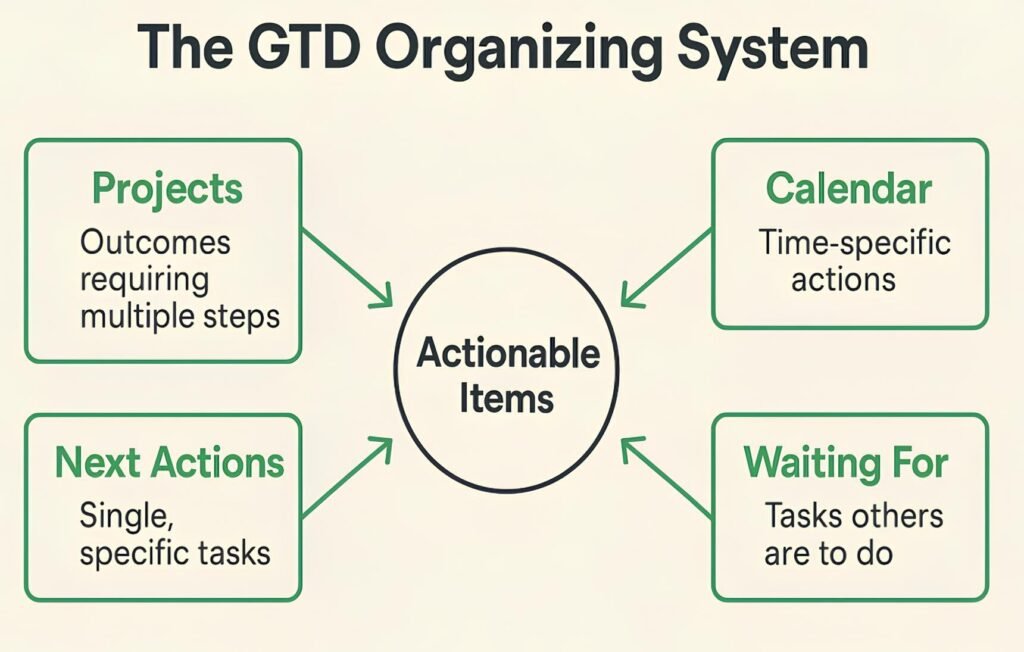Feeling Overwhelmed? This 5-Step GTD Method Will Change Your Life
Do you have a constant, low-level hum of anxiety that you’re forgetting something? Do you remember you need to buy milk while you’re in the middle of an important meeting? This is the mental clutter that drains our energy and focus. But what if you could turn it off?
The Getting Things Done (GTD) method, created by productivity consultant David Allen, is a system designed to solve this exact problem. Its foundational principle is simple but profound: your brain is for having ideas, not holding them. GTD is a complete framework for getting every task, commitment, and idea out of your head and into a trusted external system, allowing you to achieve a state of “stress-free productivity”.
Ready to get started? Here is a beginner’s guide to the five core steps of the GTD method.
Step 1: Capture – Get Everything Out of Your Head
The first and most important habit in GTD is to Capture everything that has your attention. Nothing is too big or too small. Every task, idea, worry, and appointment is considered “stuff” that needs to be collected in an “inbox”. This frees your brain from the exhausting job of trying to remember everything.
An inbox isn’t just for email; it can be a physical tray on your desk, a dedicated notebook, or a task management app. The key is to keep your capture tools minimal and always accessible. To begin, you should perform a “mind sweep”—a comprehensive brain dump where you write down every single commitment, or “open loop,” that’s on your mind.
Key Takeaway: Your goal is 100% capture. Choose a few reliable inboxes and make it a habit to get every thought out of your head and into your system the moment it appears.
Step 2: Clarify – Process Your Inbox to Zero
Once you’ve captured your “stuff,” you need to process it. The Clarify step is where you go through your inbox item by item and ask two simple questions: “What is it?” and “Is it actionable?”. You should never put an item back into the inbox once you’ve picked it up.
- If it’s NOT actionable, you have three choices:
- Trash: It’s no longer needed.
- Someday/Maybe: It’s an idea you might want to pursue later. This goes on a “Someday/Maybe” list.
- Reference: It’s useful information you want to keep. File it away in a reference system.
- If it IS actionable, you must define the “next action”—the very next physical, visible activity needed to move it forward. Then, apply the “2-Minute Rule”: if the next action can be done in two minutes or less, do it immediately. If it takes longer, you will defer it to be organized in the next step.
GTD Example 1: The Coffee Bean
Imagine the thought pops into your head: “I’m almost out of coffee.”
This is now “stuff” that needs to be processed. You run it through the GTD workflow:
- Is it actionable? Yes, you need to buy more.
- What is the “Next Action?” The very next physical step is: “Order more coffee online.”
- Apply the “2-Minute Rule” You ask yourself, “Can I do this in under two minutes?”
- If YES: You have the coffee website saved and your payment info is stored. You can grab your phone and place the order in 45 seconds. You do it immediately. The task is done and never clutters your to-do list.
- If NO: You need to research a new brand of beans, which will take about 15 minutes. You defer it. You add a task to your “Next Actions” list called “Order new coffee beans online”
Key Takeaway: Process your inbox one item at a time. Decide if it’s actionable and identify the next physical action. If it’s under two minutes, do it now. If not, it moves to the next step.
Step 3: Organize – Put Everything Where It Belongs
After you clarify an actionable item that takes longer than two minutes, you must Organize it into your trusted system. This ensures you can find it when you need it. The main categories are:
- A Project List: In GTD, a “project” is any outcome that requires more than one action step. “Prepare for presentation” is a project. This list is your inventory of bigger commitments.
- Next Action Lists: This is the core of your day-to-day productivity. These are the single, discrete tasks you can work on now. You can organize these lists by “context,” such as
@Computer,@Calls, or@Errands, so you can see what’s possible to do in your current environment. - The Calendar: Your calendar is “sacred ground”. It is only for things that have to happen on a specific day or at a specific time—appointments and hard deadlines. It is not a to-do list for things you hope to do.
- A “Waiting For” List: This is where you track all the tasks you’ve delegated to others or are waiting on an external event for.

GTD Example 2: Planning a Birthday Party
Let’s say you’ve decided to plan a surprise birthday party for your mom. In the Clarify step, you recognized this is an actionable item that will take more than two minutes. Now, in the Organize step, you place all the moving parts into your trusted system:
- Project List: First, because “Plan Mom’s Birthday Party” requires multiple steps, it goes on your Project List. This keeps the overall goal on your radar.
- Next Actions List: You decide the very next physical actions needed to get the ball rolling.
- “Call the restaurant to check availability” goes on your
@Callslist. - “Draft guest list” goes on your
@Computerlist.
- “Call the restaurant to check availability” goes on your
- Calendar: The party itself is on a specific date, September 20th. You add “Mom’s Surprise Party at 7 PM” to your Calendar. This is a hard, time-specific commitment, which is exactly what the calendar is for.
- “Waiting For” List: You text your brother to ask for his input on the guest list. You now create an item on your “Waiting For” List that says: “Waiting for guest list suggestions from Tom.”
Key Takeaway: Every actionable item has a home. Use a Project list for multi-step outcomes, Next Action lists for single tasks, and your Calendar only for time-specific commitments.
Step 4: Reflect – Keep Your System Trusted and Current
A productivity system is useless if you don’t trust it. The Reflect step is the process of regularly reviewing your system to ensure it’s complete and up-to-date. This is what keeps the entire GTD machine running smoothly.
The most important part of this step is the Weekly Review. This is a scheduled appointment with yourself to get clear, get current, and get creative. During the review, you’ll process all your inboxes to zero, review your lists, and ensure every project has a current “next action” assigned to it. This is the habit that prevents the system from failing and gives you confidence that everything is accounted for.
Key Takeaway: The Weekly Review is non-negotiable. Schedule 1-2 hours every week to maintain your system. This single habit is the key to long-term success with GTD.
Step 5: Engage – Make Trusted Choices About What to Do
The final step is to Engage—to simply do your work. With a trusted system, you no longer have to wonder what you should be doing. You can make an intelligent choice in the moment based on four criteria:
- Context: What can you do right here, right now, with the tools you have? (e.g., your
@Callslist when you have your phone). - Time Available: Do you have five minutes or a full hour?.
- Energy Available: Do you have the mental energy for a high-focus task or a low-energy one?.
- Priority: After considering the first three constraints, you use your intuition to choose the task that will deliver the most value and move you toward your most important goals.
Key Takeaway: Don’t use a rigid A-B-C priority system. Instead, make flexible, in-the-moment choices about what to work on based on your context, time, and energy.
Conclusion: Achieving Your “Mind Like Water”
The ultimate goal of the GTD method is to achieve a mental state David Allen calls “mind like water”—a mind that is calm, clear, and ready to respond appropriately to whatever comes its way. It’s not about becoming a productivity machine, but about creating the mental space to be more creative, strategic, and present in your life.
To get started, don’t try to implement everything at once. Follow this simple plan:
- Week 1: Master Capture. Focus only on getting every “open loop” out of your head and into an inbox.
- Week 2: Learn to Clarify. Start processing your inbox to zero every day.
- Week 3 and beyond: Make the Weekly Review a Habit. This is the keystone habit that holds the entire system together.
By building these habits, you can move from feeling reactive and stressed to feeling proactive and in control, confident that nothing important is falling through the cracks.
What is the first “open loop” you’re going to capture? Share your first step in the comments below!



One Comment